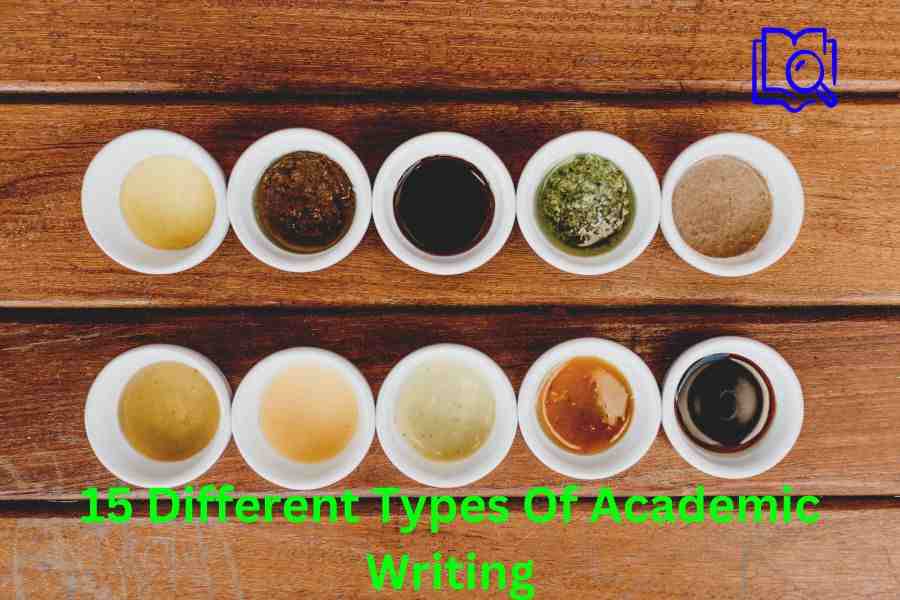Last updated on November 25th, 2025 at 12:57 pm
There are different types of academic writing, each serving distinct purposes based on the subject matter, audience, and context.
An important feature of academic writing is that it adheres to a specific tone and style that enhances credibility, clarity, and objectivity in academic writing.
Understanding these types helps writers develop the appropriate style for their research or projects.
Table of Contents
The Different Types of Academic Writing
1. Descriptive Writing
Descriptive writing is the simplest form of academic writing. It involves describing facts, events, processes, or phenomena without inserting any personal opinions or evaluations.
This type of writing is often found in book reports, literature reviews, and introductions of research papers.
Example:
A detailed account of an experimental method in a research paper or describing a historical event in a history essay.
2. Analytical Writing
Analytical writing goes beyond mere description. It breaks down information into parts, examines relationships, and interprets underlying patterns or themes.
This type of writing is common in critical reviews, comparative essays, and research papers.
Example:
A literature review comparing and contrasting various theories on a subject.
| Types of Analytical Writing | Purpose |
|---|---|
| Critical Reviews | Evaluate and analyze sources |
| Theoretical Analysis | Break down and interpret models |
3. Persuasive Writing
Persuasive writing is used to argue a point of view or persuade the reader to accept a specific stance or conclusion. In this type of writing, the author presents evidence and arguments to support their position.
This form of writing is often found in argumentative essays, proposals, and research papers with a strong thesis.
research papers with a strong thesis.
Exampl
Example:
An argumentative essay advocating for the implementation of renewable energy policies.
4. Critical Writing
Critical writing combines elements of both analysis and persuasion. It involves evaluating different viewpoints, challenging assumptions, and arguing a case using evidence.
Critical writing requires the writer to assess the work of others critically, often found in literature reviews, journal articles, and theoretical discussions.
Example:
Critique a scientific theory by presenting evidence against it or proposing an alternative explanation.
5. Research Papers
Research papers present the findings of original research conducted by the author.
This type of academic writing includes various subtypes, such as experimental papers, qualitative research reports, and quantitative studies.
The purpose of a research paper is to contribute new knowledge to a specific field.
Example:
An empirical study examining the effects of a new drug on cancer treatment.
6. Expository Writing
Expository writing explains or informs the reader about a particular topic clearly and logically.
This type of academic writing often appears in instructional manuals, reports, and essays that explain concepts or processes.
Example:
A step-by-step guide explaining the procedure for conducting a chemical experiment.
7. Reflective Writing
Reflective writing is more personal and allows the writer to reflect on their experiences, thoughts, and emotions related to a specific academic task or process.
It is often used in reflective essays and learning journals.
Example:
Reflecting on the challenges faced during a research project or coursework.
8. Report Writing
Reports are structured pieces of writing used to present information clearly and concisely, often based on research or investigation.
Reports are commonly used in the sciences, engineering, business, and other technical fields.
Example:
A lab report detailing the findings of an experiment conducted in a chemistry lab.
9. Literature Reviews
Literature reviews in research summarize and synthesize existing research on a specific topic.
They analyze the current state of knowledge, highlight gaps in the literature, and provide a foundation for new research.
Example:
A literature review summarizes studies on social media’s impact on mental health.
10. Dissertations and Theses
Dissertations and theses are extensive research papers that are usually required for completing a master’s or doctoral degree.
These documents provide in-depth analysis and discussion of a particular research question or hypothesis and represent the culmination of the student’s academic research.
Example:
A PhD dissertation examining the role of artificial intelligence in modern medicine.
11. Case Studies
Case studies provide a detailed examination and analysis of a particular case or instance.
This type of writing is often used in fields such as business, psychology, and education to explore specific issues or examples in depth.
Example:
A case study analyzing the impact of a corporate merger on employee morale.
| Type of Case Study | Focus |
|---|---|
| Business Case Studies | Analyze specific business scenarios |
| Medical Case Studies | Investigate patient conditions |
| Educational Case Studies | Explore teaching methods and outcomes |
12. Conference Papers
Conference papers are research papers or presentations given at academic conferences.
They allow scholars to present their research findings to their peers and receive feedback.
These papers are often later published in peer-reviewed journals or proceedings.
Example:
A conference paper presented at an education summit discussing innovative teaching strategies.
13. Book Reviews
Book reviews critique and evaluate recently published academic books.
They provide an analysis of the content, style, and contribution of the book to its respective field.
Example:
A review of a new book on the history of social movements.
14. White Papers
White papers are authoritative reports or guides that provide solutions to specific problems or make a case for a particular approach.
They are commonly used in business, government, and academic institutions.
Example:
A white paper advocating for using renewable energy sources in corporate sectors.
15. Research Proposals
Research proposals outline a plan for conducting research. They are often submitted to academic or funding institutions to seek approval or funding for a research project.
A well-written proposal clearly outlines the research question, methodology, and expected outcomes.
Example:
A research proposal for a study on the effects of climate change on coastal communities.
FAQs
What are the 4 types of academic writing?
The 4 types of academic writing include descriptive, analytical, persuasive, and critical.
What is the most common type of academic writing?
Descriptive writing is the most common and one of the simplest and most frequently used academic writing types. The main purpose of descriptive writing is to state facts and inform the audience.
What is level 4 academic writing?
Level 4 teaches you to structure your essay properly by writing an appropriate abstract, an introduction literature review, and following with the methodology and conclusion.
Conclusion
Academic writing encompasses various types, each serving a unique function within the academic community. From descriptive to critical writing, the types of academic writing reflect different purposes, styles, and audiences.
Mastering these academic skills helps scholars communicate effectively and contribute meaningfully to their fields of study.




